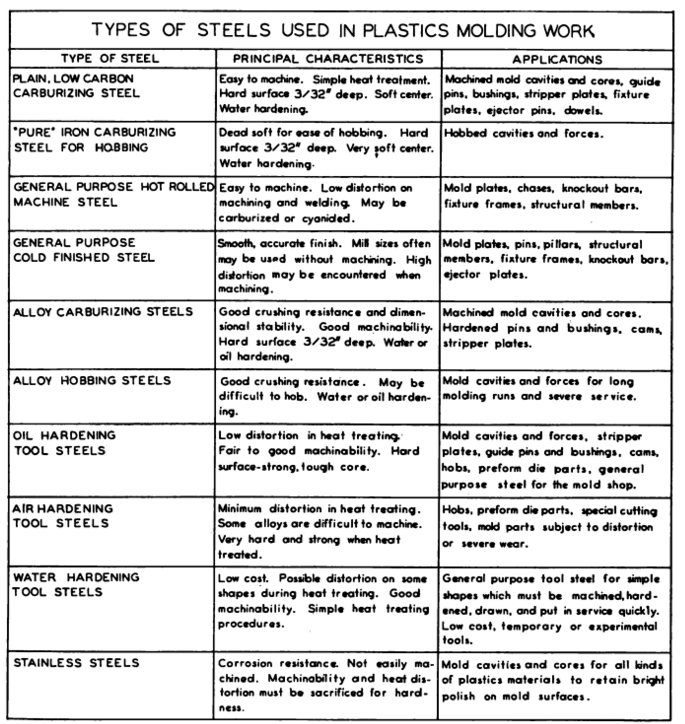Steel Used in plastic mold making
Kinds of Steel Used in Molds
In order to obtain a thorough understanding of the large amount of information concerning mold steels, it seems well to begin the study by listing the kinds of steels which are commonly employed in the fabrication of molds. The list is surprisingly long, and steelmakers find it covers a good portion of their manufacturing art to supply the steels used for plastics molds. Many of the molder’s steels may be classified as specialty steels, which are steels made in small, carefully controlled heats, or which are specially selected portions of larger mill runs.
Each of the types of steel listed in Figure 1 is available in a variety of shapes, sizes and microstructure condition. Manufacturers bulletins list available sizes and mill shapes. The meaning of these terms with respect to their application to mold work should be clearly understood by the mold designer in order to obtain satisfactory and economical results. Themoldmaker shop tool room should have a supply of each of these types of steel on hand in satisfactory size ranges to take care of urgently required new work and repair work. The machining requirements of the mold parts have bearing upon the kind of steel and upon the condition of the steel when machining is begun. These items will be briefly discussed in their relation to the kinds of steel listed in the table in Figure 1.

Figure 1.
General Purpose Low Carbon Steels
General purpose low carbon hot rolled and cold finished machine steelsare available in perhaps the greatest variety of sizes and shapes of all of the steels used for molds. Hot rolled flats, rounds, and squares are useful for mold parts which require extensive machining, and which do not require hardening. As assortment of sizes as tabulated below is useful as a stock for the tool room.
Larger sizes than those listed are available, but the listed sizes will cover most of the general work of the mold shop tool room. Flame cut slabs up to 5″ or more in thickness may be obtained from hot rolled mill stock. These, and forged slabs of thicker stock can be obtained for special sizes, and, under ordinary conditions, they may be obtained quickly from warehouse stocks. For this reason, it is not necessary to try to keep a stock of extra large pieces in anticipation of urgent work.
Hot rolled steel has a rough surface, with, or without mill scale, or iron oxide coat. The hot rolling process produces steel which essentially has no residual stresses. The rough surface is not a disadvantage because hot rolled steel usually is specified for parts which must be finished all over and otherwise machined extensively. The relatively stress free condition is an advantage when the machining is not symmetrical, as the hot rolled material is much less subject to distortion than is cold finished steel.

Gold finished steel is produced by re-rolling flat hot rolled bars which have been pickled to remove the hot-rolling scale, or by die-drawing rounds, squares, hexagons, or octagons. The process produces a smooth finish all over, and it is subject to accurate size control. However residual rolling stresses are present, and machining must be conducted carefully. If a portion of the outer skin is machined away on a cold rolled bar of steel, it may warp, because of the uneven stress balance on the remaining portion.
Standard sizes of cold finished steels are useful in the tool room. As tabulated for the hot rolled steels, the same stocklist should apply. However, large slabs and forgings cannot be obtained, due to the nature of the cold finishing process. The cold finished steels find their most advantageous use when they are used for mold parts such as plates, backing plates, pillars, spacer bars, knockout frames, and other shapes which may be machined symmetrically. Figure 8 shows some examples which apply in machining and specifying hot rolled, or cold finished steels.
In the event that the mill tolerances for size and shape of the cold finished steels are not satisfactory for work which requires greater accuracy, some shapes of mill finished hot rolled steels are available. It is often more economical to use such materials than to machine the parts all over from hot rolled steel. Turned and ground shafting, or ground and polished shafting are held to much closer size and shape tolerances than are the corresponding cold drawn rounds. Ground stripper plate stock, long a standard item for stamping dies, is often used for mold plates when better flatness is required than can be obtained by using cold rolled fiats. Large planed and ground plates are sometimes used rather than cold rolled stock, for the same reason.
